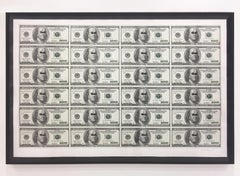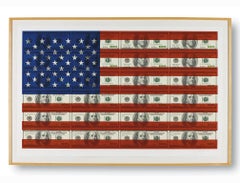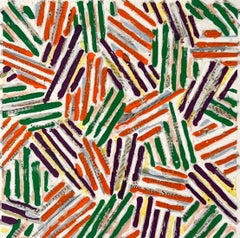Steven Gagnon Art
to
12
4
2
7
5
2
2
8
Overall Height
to
Overall Width
to
3
1
1
1
1
1
1
11
12
6,996
3,347
2,513
1,213
4
4
4
4
3
Artist: Steven Gagnon
Esso Oil Can, Pop Art Silkscreen by Steven Gagnon
By Steven Gagnon
Located in Long Island City, NY
Artist: Steven Gagnon, American (1973 - )
Title: Esso Oil Can
Year: 2006
Medium: Serigraph on Coventry, Signed and numbered in pencil
Edition: 100
Image: 36 x ...
Category
21st Century and Contemporary Pop Art Steven Gagnon Art
Materials
Screen
Hope - Progress, Pop Art Screenprints by Steven Gagnon
By Steven Gagnon
Located in Long Island City, NY
Two silkscreen prints by Steven Gagnon from 2011. Political commentary in pop art style imagery with a farcical tone. Unframed, hand signed in lower right corner.
Artist: Steven Ga...
Category
20th Century Pop Art Steven Gagnon Art
Materials
Screen
$100 U.S. Flag, Pop Art Silkscreen
By Steven Gagnon
Located in Long Island City, NY
Artist: Steven Gagnon, American (1973 - )
Title: $100 U.S. Flag
Year: 2004
Medium: Serigraph on Coventry, Signed and numbered in pencil
Edition: 75/100
Image: 36 x 60 in.
Size: 40 x...
Category
21st Century and Contemporary Pop Art Steven Gagnon Art
Materials
Screen
Innocent Until Proven Guilty
By Steven Gagnon
Located in Miami, FL
Steven Gagnon is a Miami Beach-based artist born in 1973 whose work focuses on critiquing American culture using classic iconography. He is known internationally for his paintings, p...
Category
2010s Steven Gagnon Art
Materials
Paper, Acrylic
$100 US Flag
By Steven Gagnon
Located in Miami, FL
Edition 87/100
Steven Gagnon is a Miami Beach-based artist born in 1973 whose work focuses on critiquing American culture using classic iconography. He is known internationally for ...
Category
2010s Steven Gagnon Art
Materials
Paper, Acrylic, Rag Paper
Hope & Progress
By Steven Gagnon
Located in Miami, FL
Steven Gagnon is a Miami Beach-based artist born in 1973 whose work focuses on critiquing American culture using classic iconography. He is known internationally for his paintings, p...
Category
2010s Steven Gagnon Art
Materials
Paper
Love It or Leave It
By Steven Gagnon
Located in Miami, FL
Steven Gagnon is a Miami Beach-based artist born in 1973 whose work focuses on critiquing American culture using classic iconography. He is known internationally for his paintings, p...
Category
2010s Steven Gagnon Art
Materials
Plastic, Acrylic Polymer, Wood Panel
Oil Money Study
By Steven Gagnon
Located in Miami, FL
Steven Gagnon is a Miami Beach-based artist born in 1973 whose work focuses on critiquing American culture using classic iconography. He is known internationally for his paintings, p...
Category
2010s Steven Gagnon Art
Materials
Metal
The Golden Rule
By Steven Gagnon
Located in Miami, FL
Steven Gagnon is a Miami Beach-based artist born in 1973 whose work focuses on critiquing American culture using classic iconography. He is known internationally for his paintings, p...
Category
2010s Steven Gagnon Art
Materials
Gold Leaf
Redneck Dreams
By Steven Gagnon
Located in Miami, FL
Steven Gagnon is a Miami Beach-based artist born in 1973 whose work focuses on critiquing American culture using classic iconography. He is known internationally for his paintings, p...
Category
2010s Steven Gagnon Art
Materials
Metal
Toy Soldier $ Study
By Steven Gagnon
Located in Miami, FL
Steven Gagnon is a Miami Beach-based artist born in 1973 whose work focuses on critiquing American culture using classic iconography. He is known internationally for his paintings, p...
Category
2010s Steven Gagnon Art
Materials
Metal
Esso Oil Can
By Steven Gagnon
Located in Miami, FL
Serigraph with water-based and U.V. inks on coventry rag paper. This piece is signed, dated, and numbered.
Category
Early 2000s Steven Gagnon Art
Materials
Rag Paper, Ink
Related Items
Woman with Bird - Original handsigned Screen Print - Limited /20
By Cecile De Bruijn
Located in Paris, FR
Cecile DE BRUIJN
Woman with Bird, c. 1995
Original screen print
Handsigned in pencil
Numbered / 20 ex
On vellum 76 x 56 cm (c. 30 x 22 inch)
Excellent condition
Category
1990s Pop Art Steven Gagnon Art
Materials
Screen
Jasper Johns Untitled
By Jasper Johns
Located in Washington, DC
Artist: Jasper Johns
Title: Untitled
Medium: Screenprint in colors on Patapar printing parchment
Year: 1977
Edition: 3000
Frame Size: 17" x 17"
Sheet Size: 10 5/8" x 10 1/4"
Image Si...
Category
1970s Pop Art Steven Gagnon Art
Materials
Screen
Victor Vasarely Kinetics 5
By Victor Vasarely
Located in Saint Ouen, FR
Victor Vasarely
Kinetics 5
double screen print on rhodoid and cardboard
editions of the griffon
neuchatel (switzerland)
1st edition . 1973
white wood fra...
Category
1970s Steven Gagnon Art
Materials
Paper
Somewhere to Light, Waco, Texas (16, Glenn) Classic 1960s Pop Art silkscreen
By James Rosenquist
Located in New York, NY
James Rosenquist
Somewhere to Light, WACO, Texas 1966, from the New York International Portfolio
Lithograph on wove paper
Pencil signed and numbered 112/225 on the front
Vintage fra...
Category
1960s Pop Art Steven Gagnon Art
Materials
Screen
H 17.5 in W 22.5 in D 0.5 in
The Golden Future of America (Sheehan, 92)
By Robert Indiana
Located in New York, NY
Robert Indiana
The Golden Future of America (Sheehan, 92), 1976
Silkscreen on Arches paper
Signed and dated in pencil, lower right; numbered 13/175, in pencil, lower left. Also bears printers blind stamp
Frame included: Elegantly matted and framed in a handmade wood frame
On its face, this Robert Indiana's silkscreen, based upon the eponymous painting "The Golden Future of America", is a patriotic celebration of Americana, done for the country's bicentennial year. But its looks are deceptive, as the work has a far more subversive meaning. In 2014, the Art Newspaper...
Category
1970s Pop Art Steven Gagnon Art
Materials
Screen, Pencil
Mirror #7 (C.112), 1972
By Roy Lichtenstein
Located in Greenwich, CT
Mirror #7 (C.112) is a screenprint and lithograph on paper, 29.75 x 17.37 inches, signed and dated 'rf Lichtenstein '72' lower right and numbered 62/80 lower left. From the edition of 96 (there were also 10 AP, and 6 other various proofs). Framed in a contemporary white frame.
Catalog -
Corlett, The Prints of Roy Lichtenstein - A Catalogue Raisonne 1948 - 1997, Hudson Hills Press, NY and National Gallery of Art, Washington, D.C., 2002, pg.125, #112.
About Lichtenstein’s Mirror...
Category
20th Century Pop Art Steven Gagnon Art
Materials
Lithograph, Screen
1988 Man, Signed and inscribed, Estate of Dorothy Berenson Blau, Littmann PP. 92
By Keith Haring
Located in New York, NY
Keith Haring
1988 Man, from the Estate of Dorothy Berenson Blau (with unique inscription), 1988
Silkscreen. Signed and inscribed to pioneering Miami dealer...
Category
1980s Pop Art Steven Gagnon Art
Materials
Screen, Pencil
Mirror #9 (C.114, Mirror Series), 1972
By Roy Lichtenstein
Located in Greenwich, CT
Mirror #9 (C.114) from the Mirror Series is a screenprint and lithograph on paper, 30 x 21.18 inches, signed and dated 'rf Lichtenstein '72' lower center margin and framed in a contemporary white frame.
Catalog -
Corlett, The Prints of Roy Lichtenstein - A Catalogue Raisonne 1948 - 1997, Hudson Hills Press, NY and National Gallery of Art, Washington, D.C., 2002, pg.126, #114.
About Lichtenstein’s Mirror Series (taken from Corlett):
Mirrors were an important subject in Lichtenstein’s paintings and prints of the early 1970s. From late 1969 to 1972 he painted over forty canvases depicting this subject. The first print was in 1970, with Twin Mirrors (cat. no.102) for the Guggenheim Museum. In 1972 he also produced Mirror (cat. No. 115) at Styria Studio, in addition to this Gemini G.E.L. series of nine prints. In the mid-seventies he took up the subject in sculpture, and he returned to it in prints as recently 1990, with Mirror (cat. No 246). In addition, he has often explored the related theme of reflections, incorporating them in various paintings and in several print series: Reflections (1990; cat. Nos. 239 – 245), Interiors (1990, published 1991; cat. nos. 247 – 54), and Water Lilies (1992; cat. nos. 261 – 66).
This Gemini group (catalog nos. 1-6 - 114) utilizes lithography, screenprint, line-cut, and embossing... In an interview with Lawrence Alloway, Lichtenstein noted: “You know, I am always impressed by how artificial things look – like descriptions of office furniture in newspapers. It is the most dry kind of drawing, as in the Mirrors. They really only look like mirrors if someone tells you they do. Only once you know that, they may be moved as far as possible from realism, but you want it to be taken for realism. It becomes as stylized as you can get away with, in an ordinary sense, not stylish.” As Jack Cowart has commented: “One would not actually stand in front of a Lichtenstein Mirror...
Category
20th Century Pop Art Steven Gagnon Art
Materials
Lithograph, Screen
1970's Large Silkscreen Abstract Geometric Day Glo Serigraph Pop Art Print Neon
By Chryssa Vardea-Mavromichali
Located in Surfside, FL
Silkscreen on Arches paper, Hand signed and Numbered in Pencil. Serigraph in white, back, blue gray (silver).
Chryssa Vardea-Mavromichali (Greek: Χρύσα Βαρδέα-Μαυρομιχάλη; December 31, 1933 – December 23, 2013) was a Greek American artist who worked in a wide variety of media. An American art pioneer in light art and luminist sculpture widely known for her neon, steel, aluminum and acrylic glass installations, she has always used the mononym Chryssa professionally. She worked from the mid-1950s in New York City studios and worked since 1992 in the studio she established in Neos Kosmos, Athens, Greece.
Chryssa was born in Athens into the famous Mavromichalis family from the Mani Peninsula. one of her sisters, who studied medicine, was a friend of the poet and novelist Nikos Kazantzakis.
Chryssa began painting during her teenage years and also studied to be a social worker.In 1953, on the advice of a Greek art critic, her family sent her to Paris to study at the Académie de la Grande Chaumiere where Andre Breton, Edgard Varese, and Max Ernst were among her associates and Alberto Giacometti was a visiting professor.
In 1954, at age twenty-one, Chryssa sailed for the United States, arrived in New York and went to San Francisco, California to study at the California School of Fine Arts. Returning to New York in 1955, she became a United States citizen and established a studio in the city.
Chryssa's first major work was The Cycladic Books preceded American minimalism by seventeen years.
1961, Chryssa's first solo exhibition was mounted at The Guggenheim.
1963, Chryssa's work was shown at the Museum of Modern Art in curator Dorothy Canning Miller's Americans 1963 exhibition. The artists represented in the show also included Richard Anuszkiewicz, Lee Bontecou, Robert Indiana, Richard Lindner, Marisol, Claes Oldenburg, Ad Reinhardt, James Rosenquist and others.
1966, The Gates to Times Square, regarded as "one of the most important American sculptures of all time" and "a thrilling homage to the living American culture of advertising and mass communications." The work is a 10 ft cube installation of two huge letter 'A's through which visitors may walk into "a gleaming block of stainless steel and Plexiglas that seems to quiver in the play of pale blue neon light" which is controlled by programmed timers. First shown in Manhattan's Pace Gallery, it was given to the Albright-Knox Art Gallery in Buffalo, New York in 1972.
1972, The Whitney Museum of American Art mounted a solo exhibition of works by Chryssa.
That's All (early 1970s), the central panel of a triptych related to The Gates of Times Square, was acquired by the Museum of Modern Art between 1975 and 1979.
1973, Chryssa's solo exhibition at the Gallerie Denise René was reviewed for TIME magazine by art critic Robert Hughes before it went on to the Galleries Denise René in Düsseldorf and Paris.
Other works by Chryssa in composite honeycomb aluminum and neon in the 1980s and 1990s include Chinatown, Siren, Urban Traffic, and Flapping Birds.
Chryssa 60/90 retrospective exhibition in Athens in the Mihalarias Art Center. After her long absence from Greece, a major exhibition including large aluminum sculptures - cityscapes, "neon boxes" from the Gates to the Times Square, paintings, drawings etc. was held in Athens.
In 1992, after closing her SoHo studio, which art dealer Leo Castelli had described as "one of the loveliest in the world," Chryssa returned to Greece. She found a derelict cinema which had become a storeroom stacked with abandoned school desks and chairs, behind the old Fix Brewery near the city center in Neos Kosmos, Athens. Using the desks to construct enormous benches, she converted the space into a studio for working on designs and aluminum composite honeycomb sculptures...
Category
1980s Pop Art Steven Gagnon Art
Materials
Screen
Seven
By Robert Indiana
Located in Fairlawn, OH
Seven
Screen print, 1968
Unsigned (as issued)
Edition: 2500
From: Number (10 plates), with poems by Robert Creeley
Printer: Domberger KG, Stuttgart
Publisher: Edition Domberger Stutt...
Category
1960s Pop Art Steven Gagnon Art
Materials
Screen
1970's Large Silkscreen Abstract Geometric Day Glo Serigraph Pop Art Print Neon
By Chryssa Vardea-Mavromichali
Located in Surfside, FL
Silkscreen on Arches paper, Hand signed and Numbered in Pencil. Serigraph in black, gray (silver).
Chryssa Vardea-Mavromichali (Greek: Χρύσα Βαρδέα-Μαυρομιχάλη; December 31, 1933 – December 23, 2013) was a Greek American artist who worked in a wide variety of media. An American art pioneer in light art and luminist sculpture widely known for her neon, steel, aluminum and acrylic glass installations, she has always used the mononym Chryssa professionally. She worked from the mid-1950s in New York City studios and worked since 1992 in the studio she established in Neos Kosmos, Athens, Greece.
Chryssa was born in Athens into the famous Mavromichalis family from the Mani Peninsula. one of her sisters, who studied medicine, was a friend of the poet and novelist Nikos Kazantzakis.
Chryssa began painting during her teenage years and also studied to be a social worker.In 1953, on the advice of a Greek art critic, her family sent her to Paris to study at the Académie de la Grande Chaumiere where Andre Breton, Edgard Varese, and Max Ernst were among her associates and Alberto Giacometti was a visiting professor.
In 1954, at age twenty-one, Chryssa sailed for the United States, arrived in New York and went to San Francisco, California to study at the California School of Fine Arts. Returning to New York in 1955, she became a United States citizen and established a studio in the city.
Chryssa's first major work was The Cycladic Books preceded American minimalism by seventeen years.
1961, Chryssa's first solo exhibition was mounted at The Guggenheim.
1963, Chryssa's work was shown at the Museum of Modern Art in curator Dorothy Canning Miller's Americans 1963 exhibition. The artists represented in the show also included Richard Anuszkiewicz, Lee Bontecou, Robert Indiana, Richard Lindner, Marisol, Claes Oldenburg, Ad Reinhardt, James Rosenquist and others.
1966, The Gates to Times Square, regarded as "one of the most important American sculptures of all time" and "a thrilling homage to the living American culture of advertising and mass communications." The work is a 10 ft cube installation of two huge letter 'A's through which visitors may walk into "a gleaming block of stainless steel and Plexiglas that seems to quiver in the play of pale blue neon light" which is controlled by programmed timers. First shown in Manhattan's Pace Gallery, it was given to the Albright-Knox Art Gallery in Buffalo, New York in 1972.
1972, The Whitney Museum of American Art mounted a solo exhibition of works by Chryssa.
That's All (early 1970s), the central panel of a triptych related to The Gates of Times Square, was acquired by the Museum of Modern Art between 1975 and 1979.
1973, Chryssa's solo exhibition at the Gallerie Denise René was reviewed for TIME magazine by art critic Robert Hughes before it went on to the Galleries Denise René in Düsseldorf and Paris.
Other works by Chryssa in composite honeycomb aluminum and neon in the 1980s and 1990s include Chinatown, Siren, Urban Traffic, and Flapping Birds.
Chryssa 60/90 retrospective exhibition in Athens in the Mihalarias Art Center. After her long absence from Greece, a major exhibition including large aluminum sculptures - cityscapes, "neon boxes" from the Gates to the Times Square, paintings, drawings etc. was held in Athens.
In 1992, after closing her SoHo studio, which art dealer Leo Castelli had described as "one of the loveliest in the world," Chryssa returned to Greece. She found a derelict cinema which had become a storeroom stacked with abandoned school desks and chairs, behind the old Fix Brewery near the city center in Neos Kosmos, Athens. Using the desks to construct enormous benches, she converted the space into a studio for working on designs and aluminum composite honeycomb sculptures...
Category
1980s Pop Art Steven Gagnon Art
Materials
Screen
Twin Mirrors (C.102), 1970
By Roy Lichtenstein
Located in Greenwich, CT
Twin Mirrors (C.102) is a screenprint on paper created for the Guggenheim Museum in 1970, 35 x 21 inches image size, signed and dated 'rf Lichtenstein '70' lower right and numbered 94/250 lower left (from the edition of 250 plus an unknown number of artist proofs). Framed in a contemporary white frame.
Catalog -
Corlett, The Prints of Roy Lichtenstein - A Catalogue Raisonne 1948 - 1997, Hudson Hills Press, NY and National Gallery of Art, Washington, D.C., 2002, pg.118, #102.
About Lichtenstein’s Mirror...
Category
20th Century Pop Art Steven Gagnon Art
Materials
Paper, Screen
Steven Gagnon art for sale on 1stDibs.
Find a wide variety of authentic Steven Gagnon art available for sale on 1stDibs. If you’re browsing the collection of art to introduce a pop of color in a neutral corner of your living room or bedroom, you can find work that includes elements of purple and other colors. You can also browse by medium to find art by Steven Gagnon in panel, wood panel, metal and more. Much of the original work by this artist or collective was created during the 21st century and contemporary and is mostly associated with the Pop Art style. Not every interior allows for large Steven Gagnon art, so small editions measuring 15 inches across are available. Customers who are interested in this artist might also find the work of David Morico, Shawn Kolodny, and Devin Miles. Steven Gagnon art prices can differ depending upon medium, time period and other attributes. On 1stDibs, the price for these items starts at $2,000 and tops out at $7,500, while the average work can sell for $3,200.





